Corporate Takeover Decision Making and Effects on Consolidated Accounting
VerifiedAdded on 2023/04/04
|10
|3001
|492
AI Summary
This report explores the effects of corporate takeover decision making on consolidated accounting, including key differences between equity accounting and consolidated accounting, treatment of intra group transactions, and NCI disclosure requirements.
Contribute Materials
Your contribution can guide someone’s learning journey. Share your
documents today.
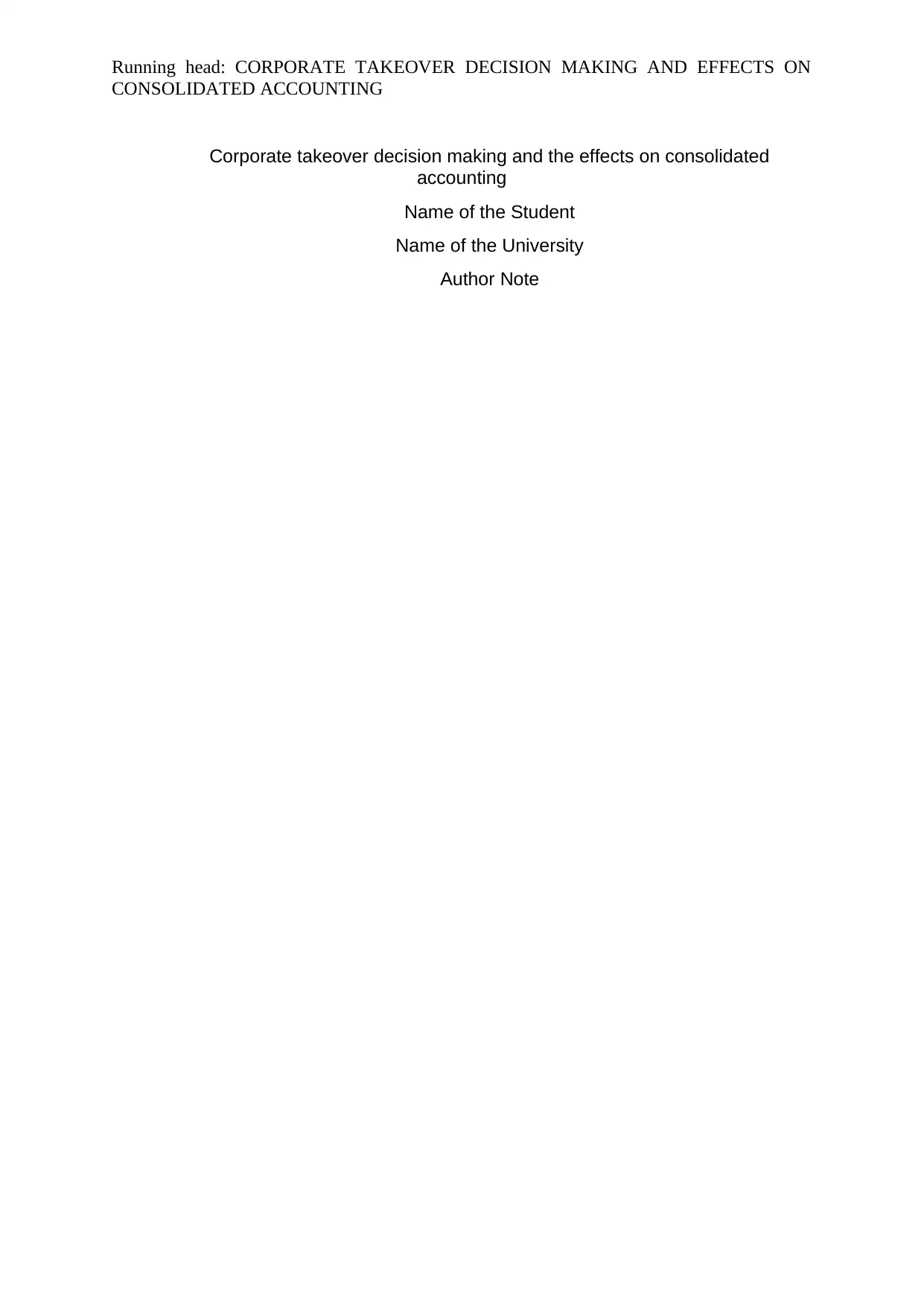
Running head: CORPORATE TAKEOVER DECISION MAKING AND EFFECTS ON
CONSOLIDATED ACCOUNTING
Corporate takeover decision making and the effects on consolidated
accounting
Name of the Student
Name of the University
Author Note
CONSOLIDATED ACCOUNTING
Corporate takeover decision making and the effects on consolidated
accounting
Name of the Student
Name of the University
Author Note
Secure Best Marks with AI Grader
Need help grading? Try our AI Grader for instant feedback on your assignments.
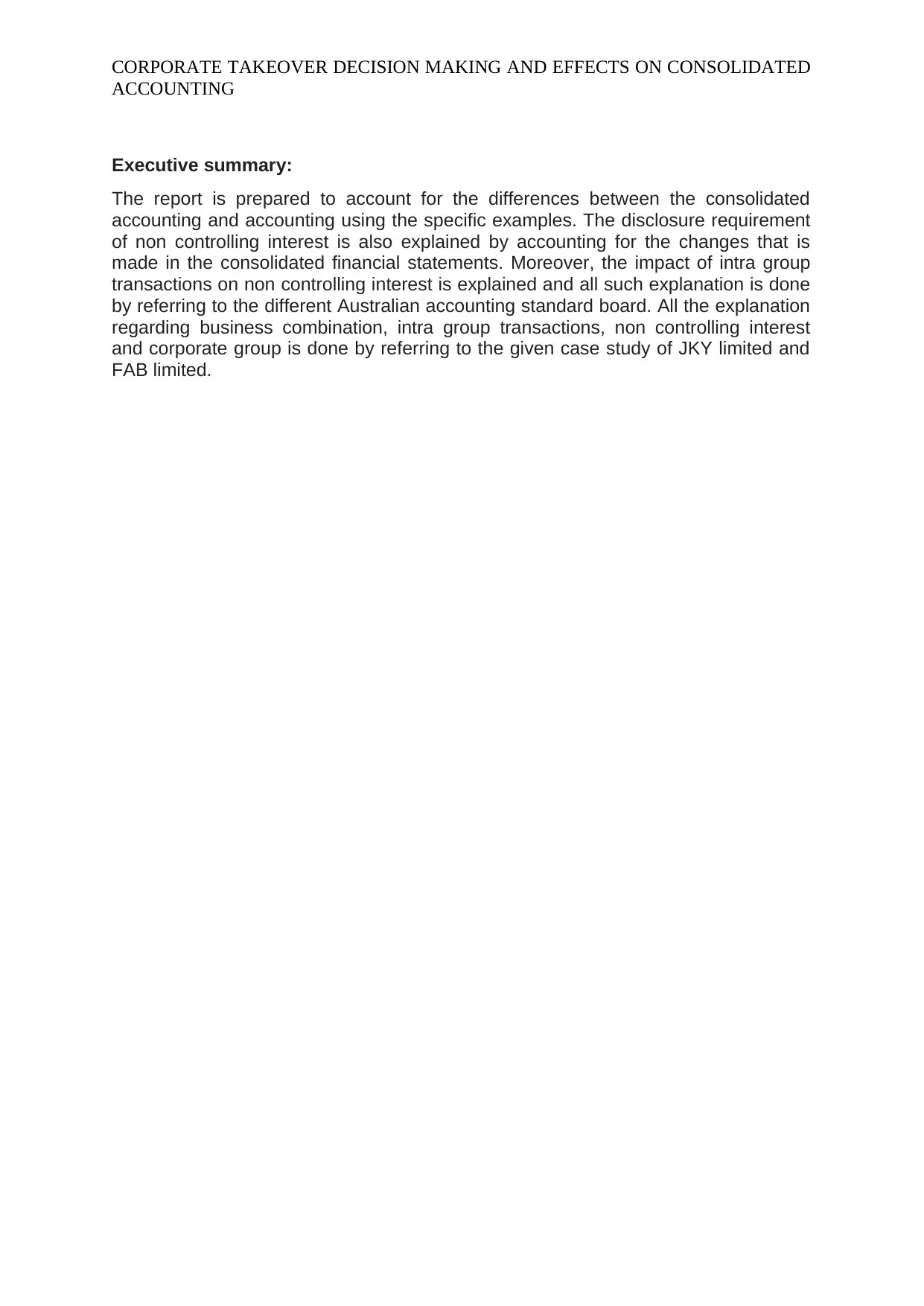
CORPORATE TAKEOVER DECISION MAKING AND EFFECTS ON CONSOLIDATED
ACCOUNTING
Executive summary:
The report is prepared to account for the differences between the consolidated
accounting and accounting using the specific examples. The disclosure requirement
of non controlling interest is also explained by accounting for the changes that is
made in the consolidated financial statements. Moreover, the impact of intra group
transactions on non controlling interest is explained and all such explanation is done
by referring to the different Australian accounting standard board. All the explanation
regarding business combination, intra group transactions, non controlling interest
and corporate group is done by referring to the given case study of JKY limited and
FAB limited.
ACCOUNTING
Executive summary:
The report is prepared to account for the differences between the consolidated
accounting and accounting using the specific examples. The disclosure requirement
of non controlling interest is also explained by accounting for the changes that is
made in the consolidated financial statements. Moreover, the impact of intra group
transactions on non controlling interest is explained and all such explanation is done
by referring to the different Australian accounting standard board. All the explanation
regarding business combination, intra group transactions, non controlling interest
and corporate group is done by referring to the given case study of JKY limited and
FAB limited.
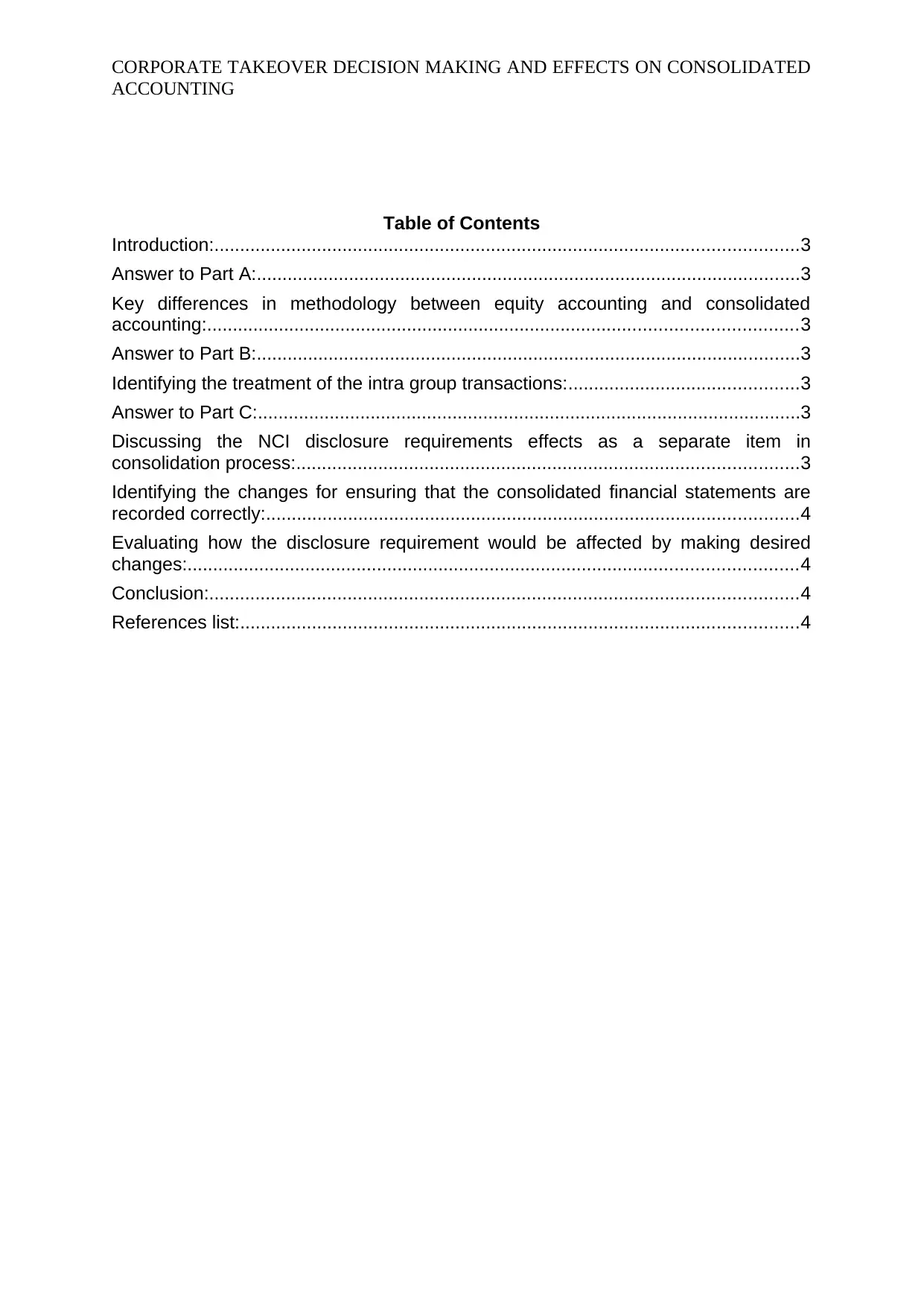
CORPORATE TAKEOVER DECISION MAKING AND EFFECTS ON CONSOLIDATED
ACCOUNTING
Table of Contents
Introduction:..................................................................................................................3
Answer to Part A:..........................................................................................................3
Key differences in methodology between equity accounting and consolidated
accounting:...................................................................................................................3
Answer to Part B:..........................................................................................................3
Identifying the treatment of the intra group transactions:.............................................3
Answer to Part C:..........................................................................................................3
Discussing the NCI disclosure requirements effects as a separate item in
consolidation process:..................................................................................................3
Identifying the changes for ensuring that the consolidated financial statements are
recorded correctly:........................................................................................................4
Evaluating how the disclosure requirement would be affected by making desired
changes:.......................................................................................................................4
Conclusion:...................................................................................................................4
References list:.............................................................................................................4
ACCOUNTING
Table of Contents
Introduction:..................................................................................................................3
Answer to Part A:..........................................................................................................3
Key differences in methodology between equity accounting and consolidated
accounting:...................................................................................................................3
Answer to Part B:..........................................................................................................3
Identifying the treatment of the intra group transactions:.............................................3
Answer to Part C:..........................................................................................................3
Discussing the NCI disclosure requirements effects as a separate item in
consolidation process:..................................................................................................3
Identifying the changes for ensuring that the consolidated financial statements are
recorded correctly:........................................................................................................4
Evaluating how the disclosure requirement would be affected by making desired
changes:.......................................................................................................................4
Conclusion:...................................................................................................................4
References list:.............................................................................................................4
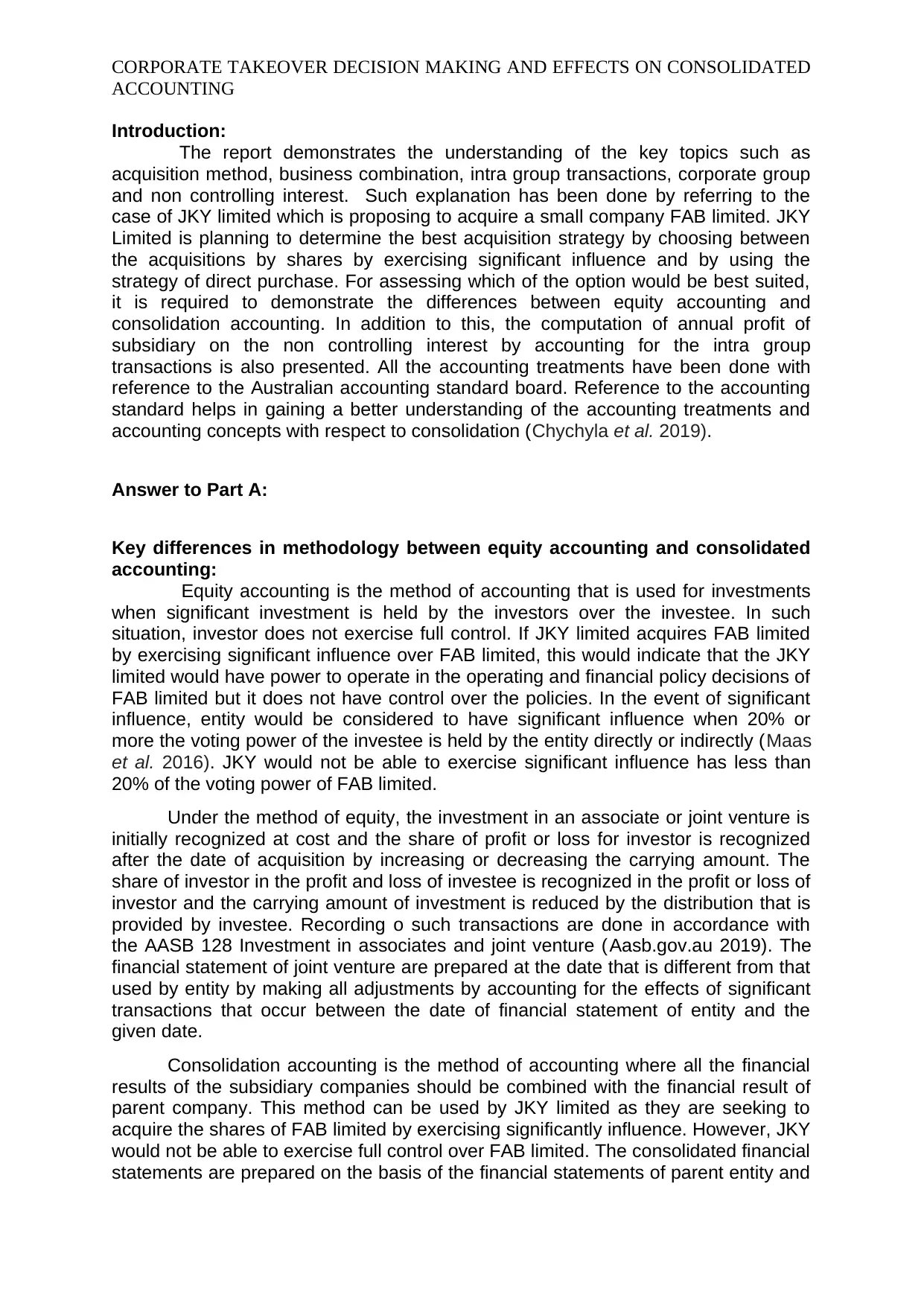
CORPORATE TAKEOVER DECISION MAKING AND EFFECTS ON CONSOLIDATED
ACCOUNTING
Introduction:
The report demonstrates the understanding of the key topics such as
acquisition method, business combination, intra group transactions, corporate group
and non controlling interest. Such explanation has been done by referring to the
case of JKY limited which is proposing to acquire a small company FAB limited. JKY
Limited is planning to determine the best acquisition strategy by choosing between
the acquisitions by shares by exercising significant influence and by using the
strategy of direct purchase. For assessing which of the option would be best suited,
it is required to demonstrate the differences between equity accounting and
consolidation accounting. In addition to this, the computation of annual profit of
subsidiary on the non controlling interest by accounting for the intra group
transactions is also presented. All the accounting treatments have been done with
reference to the Australian accounting standard board. Reference to the accounting
standard helps in gaining a better understanding of the accounting treatments and
accounting concepts with respect to consolidation (Chychyla et al. 2019).
Answer to Part A:
Key differences in methodology between equity accounting and consolidated
accounting:
Equity accounting is the method of accounting that is used for investments
when significant investment is held by the investors over the investee. In such
situation, investor does not exercise full control. If JKY limited acquires FAB limited
by exercising significant influence over FAB limited, this would indicate that the JKY
limited would have power to operate in the operating and financial policy decisions of
FAB limited but it does not have control over the policies. In the event of significant
influence, entity would be considered to have significant influence when 20% or
more the voting power of the investee is held by the entity directly or indirectly (Maas
et al. 2016). JKY would not be able to exercise significant influence has less than
20% of the voting power of FAB limited.
Under the method of equity, the investment in an associate or joint venture is
initially recognized at cost and the share of profit or loss for investor is recognized
after the date of acquisition by increasing or decreasing the carrying amount. The
share of investor in the profit and loss of investee is recognized in the profit or loss of
investor and the carrying amount of investment is reduced by the distribution that is
provided by investee. Recording o such transactions are done in accordance with
the AASB 128 Investment in associates and joint venture (Aasb.gov.au 2019). The
financial statement of joint venture are prepared at the date that is different from that
used by entity by making all adjustments by accounting for the effects of significant
transactions that occur between the date of financial statement of entity and the
given date.
Consolidation accounting is the method of accounting where all the financial
results of the subsidiary companies should be combined with the financial result of
parent company. This method can be used by JKY limited as they are seeking to
acquire the shares of FAB limited by exercising significantly influence. However, JKY
would not be able to exercise full control over FAB limited. The consolidated financial
statements are prepared on the basis of the financial statements of parent entity and
ACCOUNTING
Introduction:
The report demonstrates the understanding of the key topics such as
acquisition method, business combination, intra group transactions, corporate group
and non controlling interest. Such explanation has been done by referring to the
case of JKY limited which is proposing to acquire a small company FAB limited. JKY
Limited is planning to determine the best acquisition strategy by choosing between
the acquisitions by shares by exercising significant influence and by using the
strategy of direct purchase. For assessing which of the option would be best suited,
it is required to demonstrate the differences between equity accounting and
consolidation accounting. In addition to this, the computation of annual profit of
subsidiary on the non controlling interest by accounting for the intra group
transactions is also presented. All the accounting treatments have been done with
reference to the Australian accounting standard board. Reference to the accounting
standard helps in gaining a better understanding of the accounting treatments and
accounting concepts with respect to consolidation (Chychyla et al. 2019).
Answer to Part A:
Key differences in methodology between equity accounting and consolidated
accounting:
Equity accounting is the method of accounting that is used for investments
when significant investment is held by the investors over the investee. In such
situation, investor does not exercise full control. If JKY limited acquires FAB limited
by exercising significant influence over FAB limited, this would indicate that the JKY
limited would have power to operate in the operating and financial policy decisions of
FAB limited but it does not have control over the policies. In the event of significant
influence, entity would be considered to have significant influence when 20% or
more the voting power of the investee is held by the entity directly or indirectly (Maas
et al. 2016). JKY would not be able to exercise significant influence has less than
20% of the voting power of FAB limited.
Under the method of equity, the investment in an associate or joint venture is
initially recognized at cost and the share of profit or loss for investor is recognized
after the date of acquisition by increasing or decreasing the carrying amount. The
share of investor in the profit and loss of investee is recognized in the profit or loss of
investor and the carrying amount of investment is reduced by the distribution that is
provided by investee. Recording o such transactions are done in accordance with
the AASB 128 Investment in associates and joint venture (Aasb.gov.au 2019). The
financial statement of joint venture are prepared at the date that is different from that
used by entity by making all adjustments by accounting for the effects of significant
transactions that occur between the date of financial statement of entity and the
given date.
Consolidation accounting is the method of accounting where all the financial
results of the subsidiary companies should be combined with the financial result of
parent company. This method can be used by JKY limited as they are seeking to
acquire the shares of FAB limited by exercising significantly influence. However, JKY
would not be able to exercise full control over FAB limited. The consolidated financial
statements are prepared on the basis of the financial statements of parent entity and
Paraphrase This Document
Need a fresh take? Get an instant paraphrase of this document with our AI Paraphraser

CORPORATE TAKEOVER DECISION MAKING AND EFFECTS ON CONSOLIDATED
ACCOUNTING
the entire subsidiary that is owned by parent entity. Preparation of consolidated
financial statements is done using reverse acquisition strategy in accordance with
the paragraph B21 of AASB 3 Business combination (Aasb.gov.au 2019). The
reverse acquisition is issued which is described in the notes to financial statements
and under the name of legal parent company. All the liabilities and assets of legal
subsidiary that is measured and recognized at the pre combinations of their carrying
amount are reflected in the consolidated financial statements. It also includes equity
balances and retained earnings of subsidiary before the business combination.
This can be explained with the help of an example. Suppose JKY limited buy
30% of the shares in $ 1 million FAB Company with an expense of $ 300000. This $
300000 is reported as an acquisition of asset in the balance sheet. However, if JKY
limited has control over JKY limited, then it is required to prepare consolidated
financial statements. In such situation, the expense, assets and income of FAB
limited would be added to the parent company that is JKY limited. For instance, if
JKY limited generates $ 200000 and subsidiary brings in $ 160000, then the total
reported income under consolidation accounting would be $ 360000.
Answer to Part B:
Identifying the treatment of the intra group transactions:
The financial statements of subsidiaries and parent entity used in the
preparation of consolidated financial statements should be prepared at the same
date. When the parent is different from subsidiary at the reporting date, for the
purpose of consolidation, the subsidiary is required to prepare additional financial
statements at the same date for which the financial statements is prepared by
subsidiary. Such treatments are done unless it is impracticable to do so.
Presentation of non controlling interest should be done in the consolidated financial
statements under the equity in the statement of financial position separately from the
equity of owner of the parent (Armstrong et al. 2015).
The non controlling interest is presented by parent company in the
consolidated statements of financial position within the equity that is separate from
the equity of parent. The financial information presented in the consolidated financial
statements presents the information about the group as single economic entity. In
such situation, there is complete elimination of carrying amount of investment of
parent in each subsidiary. There is identification of non controlling interest in the
consolidated subsidiaries profit and loss. In addition to this, there is separate
identification of net assets of consolidated subsidiaries in the non controlling interest
(De Waegenaer et al. 2019).
The transactions and intra group balances including dividends, expenses and
income are eliminated completely. Any intra group transactions resulting profits and
loss that are recognized in the assets such as fixed assets and inventory are
eliminated completely in accordance with the paragraph 21 of AASB 127 of the
consolidated and separate financial statements. An impairment that requires getting
recognized in the consolidated financial statements is indicated by the intra group
losses. Any temporary differences arising from the profit and loss elimination due to
intergroup transactions is applicable under AASB 112 Income tax (Aasb.gov.au
ACCOUNTING
the entire subsidiary that is owned by parent entity. Preparation of consolidated
financial statements is done using reverse acquisition strategy in accordance with
the paragraph B21 of AASB 3 Business combination (Aasb.gov.au 2019). The
reverse acquisition is issued which is described in the notes to financial statements
and under the name of legal parent company. All the liabilities and assets of legal
subsidiary that is measured and recognized at the pre combinations of their carrying
amount are reflected in the consolidated financial statements. It also includes equity
balances and retained earnings of subsidiary before the business combination.
This can be explained with the help of an example. Suppose JKY limited buy
30% of the shares in $ 1 million FAB Company with an expense of $ 300000. This $
300000 is reported as an acquisition of asset in the balance sheet. However, if JKY
limited has control over JKY limited, then it is required to prepare consolidated
financial statements. In such situation, the expense, assets and income of FAB
limited would be added to the parent company that is JKY limited. For instance, if
JKY limited generates $ 200000 and subsidiary brings in $ 160000, then the total
reported income under consolidation accounting would be $ 360000.
Answer to Part B:
Identifying the treatment of the intra group transactions:
The financial statements of subsidiaries and parent entity used in the
preparation of consolidated financial statements should be prepared at the same
date. When the parent is different from subsidiary at the reporting date, for the
purpose of consolidation, the subsidiary is required to prepare additional financial
statements at the same date for which the financial statements is prepared by
subsidiary. Such treatments are done unless it is impracticable to do so.
Presentation of non controlling interest should be done in the consolidated financial
statements under the equity in the statement of financial position separately from the
equity of owner of the parent (Armstrong et al. 2015).
The non controlling interest is presented by parent company in the
consolidated statements of financial position within the equity that is separate from
the equity of parent. The financial information presented in the consolidated financial
statements presents the information about the group as single economic entity. In
such situation, there is complete elimination of carrying amount of investment of
parent in each subsidiary. There is identification of non controlling interest in the
consolidated subsidiaries profit and loss. In addition to this, there is separate
identification of net assets of consolidated subsidiaries in the non controlling interest
(De Waegenaer et al. 2019).
The transactions and intra group balances including dividends, expenses and
income are eliminated completely. Any intra group transactions resulting profits and
loss that are recognized in the assets such as fixed assets and inventory are
eliminated completely in accordance with the paragraph 21 of AASB 127 of the
consolidated and separate financial statements. An impairment that requires getting
recognized in the consolidated financial statements is indicated by the intra group
losses. Any temporary differences arising from the profit and loss elimination due to
intergroup transactions is applicable under AASB 112 Income tax (Aasb.gov.au
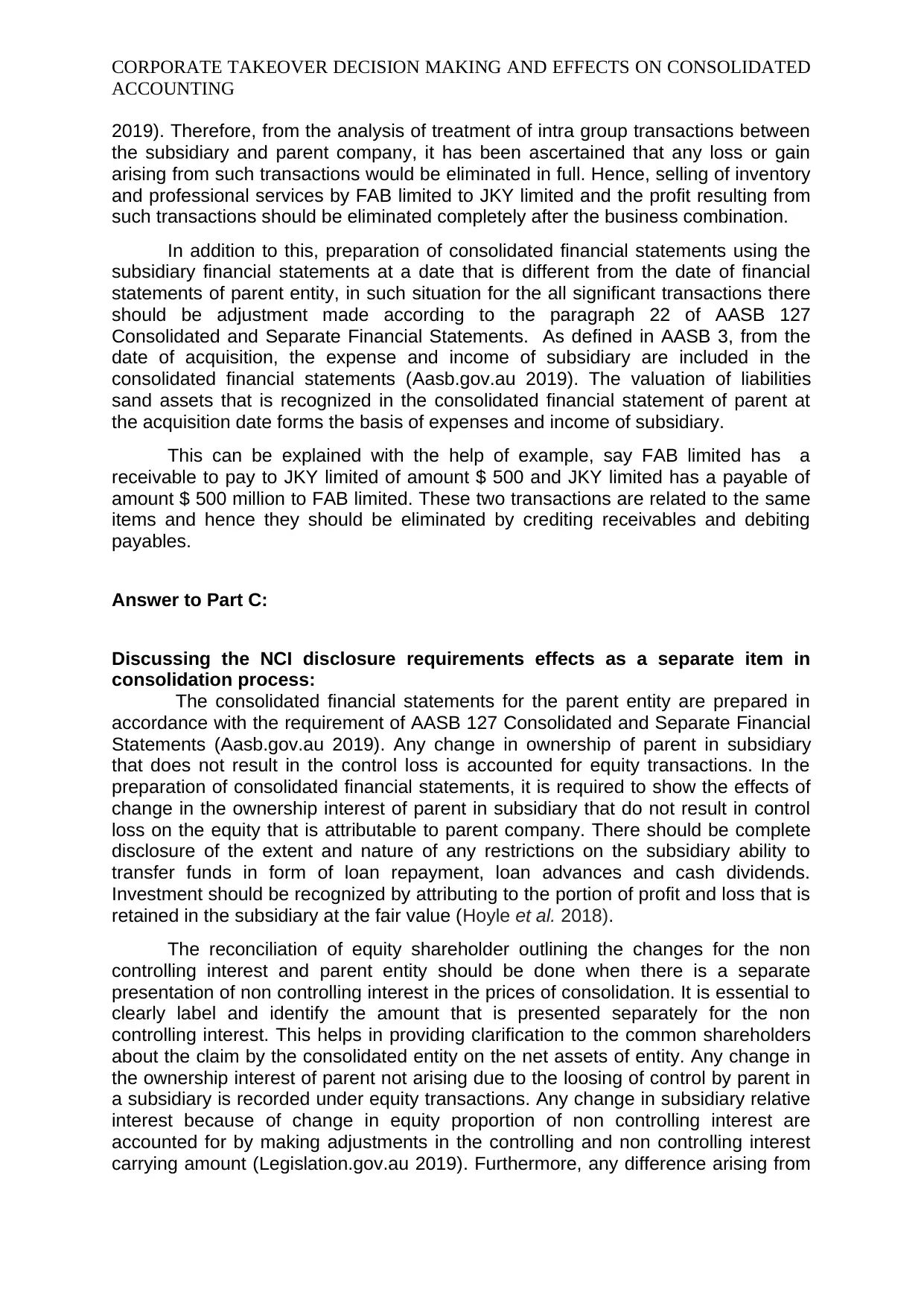
CORPORATE TAKEOVER DECISION MAKING AND EFFECTS ON CONSOLIDATED
ACCOUNTING
2019). Therefore, from the analysis of treatment of intra group transactions between
the subsidiary and parent company, it has been ascertained that any loss or gain
arising from such transactions would be eliminated in full. Hence, selling of inventory
and professional services by FAB limited to JKY limited and the profit resulting from
such transactions should be eliminated completely after the business combination.
In addition to this, preparation of consolidated financial statements using the
subsidiary financial statements at a date that is different from the date of financial
statements of parent entity, in such situation for the all significant transactions there
should be adjustment made according to the paragraph 22 of AASB 127
Consolidated and Separate Financial Statements. As defined in AASB 3, from the
date of acquisition, the expense and income of subsidiary are included in the
consolidated financial statements (Aasb.gov.au 2019). The valuation of liabilities
sand assets that is recognized in the consolidated financial statement of parent at
the acquisition date forms the basis of expenses and income of subsidiary.
This can be explained with the help of example, say FAB limited has a
receivable to pay to JKY limited of amount $ 500 and JKY limited has a payable of
amount $ 500 million to FAB limited. These two transactions are related to the same
items and hence they should be eliminated by crediting receivables and debiting
payables.
Answer to Part C:
Discussing the NCI disclosure requirements effects as a separate item in
consolidation process:
The consolidated financial statements for the parent entity are prepared in
accordance with the requirement of AASB 127 Consolidated and Separate Financial
Statements (Aasb.gov.au 2019). Any change in ownership of parent in subsidiary
that does not result in the control loss is accounted for equity transactions. In the
preparation of consolidated financial statements, it is required to show the effects of
change in the ownership interest of parent in subsidiary that do not result in control
loss on the equity that is attributable to parent company. There should be complete
disclosure of the extent and nature of any restrictions on the subsidiary ability to
transfer funds in form of loan repayment, loan advances and cash dividends.
Investment should be recognized by attributing to the portion of profit and loss that is
retained in the subsidiary at the fair value (Hoyle et al. 2018).
The reconciliation of equity shareholder outlining the changes for the non
controlling interest and parent entity should be done when there is a separate
presentation of non controlling interest in the prices of consolidation. It is essential to
clearly label and identify the amount that is presented separately for the non
controlling interest. This helps in providing clarification to the common shareholders
about the claim by the consolidated entity on the net assets of entity. Any change in
the ownership interest of parent not arising due to the loosing of control by parent in
a subsidiary is recorded under equity transactions. Any change in subsidiary relative
interest because of change in equity proportion of non controlling interest are
accounted for by making adjustments in the controlling and non controlling interest
carrying amount (Legislation.gov.au 2019). Furthermore, any difference arising from
ACCOUNTING
2019). Therefore, from the analysis of treatment of intra group transactions between
the subsidiary and parent company, it has been ascertained that any loss or gain
arising from such transactions would be eliminated in full. Hence, selling of inventory
and professional services by FAB limited to JKY limited and the profit resulting from
such transactions should be eliminated completely after the business combination.
In addition to this, preparation of consolidated financial statements using the
subsidiary financial statements at a date that is different from the date of financial
statements of parent entity, in such situation for the all significant transactions there
should be adjustment made according to the paragraph 22 of AASB 127
Consolidated and Separate Financial Statements. As defined in AASB 3, from the
date of acquisition, the expense and income of subsidiary are included in the
consolidated financial statements (Aasb.gov.au 2019). The valuation of liabilities
sand assets that is recognized in the consolidated financial statement of parent at
the acquisition date forms the basis of expenses and income of subsidiary.
This can be explained with the help of example, say FAB limited has a
receivable to pay to JKY limited of amount $ 500 and JKY limited has a payable of
amount $ 500 million to FAB limited. These two transactions are related to the same
items and hence they should be eliminated by crediting receivables and debiting
payables.
Answer to Part C:
Discussing the NCI disclosure requirements effects as a separate item in
consolidation process:
The consolidated financial statements for the parent entity are prepared in
accordance with the requirement of AASB 127 Consolidated and Separate Financial
Statements (Aasb.gov.au 2019). Any change in ownership of parent in subsidiary
that does not result in the control loss is accounted for equity transactions. In the
preparation of consolidated financial statements, it is required to show the effects of
change in the ownership interest of parent in subsidiary that do not result in control
loss on the equity that is attributable to parent company. There should be complete
disclosure of the extent and nature of any restrictions on the subsidiary ability to
transfer funds in form of loan repayment, loan advances and cash dividends.
Investment should be recognized by attributing to the portion of profit and loss that is
retained in the subsidiary at the fair value (Hoyle et al. 2018).
The reconciliation of equity shareholder outlining the changes for the non
controlling interest and parent entity should be done when there is a separate
presentation of non controlling interest in the prices of consolidation. It is essential to
clearly label and identify the amount that is presented separately for the non
controlling interest. This helps in providing clarification to the common shareholders
about the claim by the consolidated entity on the net assets of entity. Any change in
the ownership interest of parent not arising due to the loosing of control by parent in
a subsidiary is recorded under equity transactions. Any change in subsidiary relative
interest because of change in equity proportion of non controlling interest are
accounted for by making adjustments in the controlling and non controlling interest
carrying amount (Legislation.gov.au 2019). Furthermore, any difference arising from
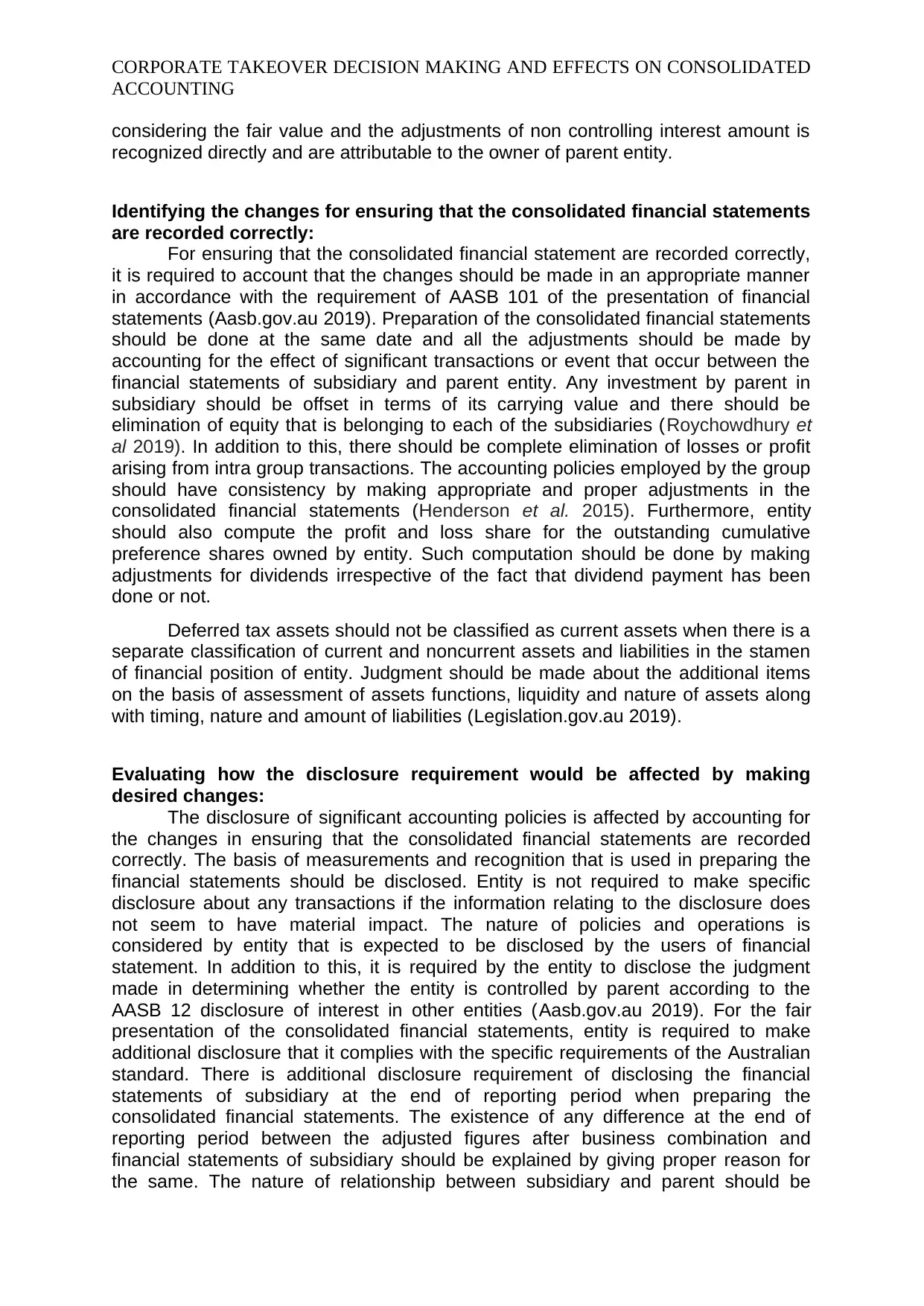
CORPORATE TAKEOVER DECISION MAKING AND EFFECTS ON CONSOLIDATED
ACCOUNTING
considering the fair value and the adjustments of non controlling interest amount is
recognized directly and are attributable to the owner of parent entity.
Identifying the changes for ensuring that the consolidated financial statements
are recorded correctly:
For ensuring that the consolidated financial statement are recorded correctly,
it is required to account that the changes should be made in an appropriate manner
in accordance with the requirement of AASB 101 of the presentation of financial
statements (Aasb.gov.au 2019). Preparation of the consolidated financial statements
should be done at the same date and all the adjustments should be made by
accounting for the effect of significant transactions or event that occur between the
financial statements of subsidiary and parent entity. Any investment by parent in
subsidiary should be offset in terms of its carrying value and there should be
elimination of equity that is belonging to each of the subsidiaries (Roychowdhury et
al 2019). In addition to this, there should be complete elimination of losses or profit
arising from intra group transactions. The accounting policies employed by the group
should have consistency by making appropriate and proper adjustments in the
consolidated financial statements (Henderson et al. 2015). Furthermore, entity
should also compute the profit and loss share for the outstanding cumulative
preference shares owned by entity. Such computation should be done by making
adjustments for dividends irrespective of the fact that dividend payment has been
done or not.
Deferred tax assets should not be classified as current assets when there is a
separate classification of current and noncurrent assets and liabilities in the stamen
of financial position of entity. Judgment should be made about the additional items
on the basis of assessment of assets functions, liquidity and nature of assets along
with timing, nature and amount of liabilities (Legislation.gov.au 2019).
Evaluating how the disclosure requirement would be affected by making
desired changes:
The disclosure of significant accounting policies is affected by accounting for
the changes in ensuring that the consolidated financial statements are recorded
correctly. The basis of measurements and recognition that is used in preparing the
financial statements should be disclosed. Entity is not required to make specific
disclosure about any transactions if the information relating to the disclosure does
not seem to have material impact. The nature of policies and operations is
considered by entity that is expected to be disclosed by the users of financial
statement. In addition to this, it is required by the entity to disclose the judgment
made in determining whether the entity is controlled by parent according to the
AASB 12 disclosure of interest in other entities (Aasb.gov.au 2019). For the fair
presentation of the consolidated financial statements, entity is required to make
additional disclosure that it complies with the specific requirements of the Australian
standard. There is additional disclosure requirement of disclosing the financial
statements of subsidiary at the end of reporting period when preparing the
consolidated financial statements. The existence of any difference at the end of
reporting period between the adjusted figures after business combination and
financial statements of subsidiary should be explained by giving proper reason for
the same. The nature of relationship between subsidiary and parent should be
ACCOUNTING
considering the fair value and the adjustments of non controlling interest amount is
recognized directly and are attributable to the owner of parent entity.
Identifying the changes for ensuring that the consolidated financial statements
are recorded correctly:
For ensuring that the consolidated financial statement are recorded correctly,
it is required to account that the changes should be made in an appropriate manner
in accordance with the requirement of AASB 101 of the presentation of financial
statements (Aasb.gov.au 2019). Preparation of the consolidated financial statements
should be done at the same date and all the adjustments should be made by
accounting for the effect of significant transactions or event that occur between the
financial statements of subsidiary and parent entity. Any investment by parent in
subsidiary should be offset in terms of its carrying value and there should be
elimination of equity that is belonging to each of the subsidiaries (Roychowdhury et
al 2019). In addition to this, there should be complete elimination of losses or profit
arising from intra group transactions. The accounting policies employed by the group
should have consistency by making appropriate and proper adjustments in the
consolidated financial statements (Henderson et al. 2015). Furthermore, entity
should also compute the profit and loss share for the outstanding cumulative
preference shares owned by entity. Such computation should be done by making
adjustments for dividends irrespective of the fact that dividend payment has been
done or not.
Deferred tax assets should not be classified as current assets when there is a
separate classification of current and noncurrent assets and liabilities in the stamen
of financial position of entity. Judgment should be made about the additional items
on the basis of assessment of assets functions, liquidity and nature of assets along
with timing, nature and amount of liabilities (Legislation.gov.au 2019).
Evaluating how the disclosure requirement would be affected by making
desired changes:
The disclosure of significant accounting policies is affected by accounting for
the changes in ensuring that the consolidated financial statements are recorded
correctly. The basis of measurements and recognition that is used in preparing the
financial statements should be disclosed. Entity is not required to make specific
disclosure about any transactions if the information relating to the disclosure does
not seem to have material impact. The nature of policies and operations is
considered by entity that is expected to be disclosed by the users of financial
statement. In addition to this, it is required by the entity to disclose the judgment
made in determining whether the entity is controlled by parent according to the
AASB 12 disclosure of interest in other entities (Aasb.gov.au 2019). For the fair
presentation of the consolidated financial statements, entity is required to make
additional disclosure that it complies with the specific requirements of the Australian
standard. There is additional disclosure requirement of disclosing the financial
statements of subsidiary at the end of reporting period when preparing the
consolidated financial statements. The existence of any difference at the end of
reporting period between the adjusted figures after business combination and
financial statements of subsidiary should be explained by giving proper reason for
the same. The nature of relationship between subsidiary and parent should be
Secure Best Marks with AI Grader
Need help grading? Try our AI Grader for instant feedback on your assignments.

CORPORATE TAKEOVER DECISION MAKING AND EFFECTS ON CONSOLIDATED
ACCOUNTING
indentified and disclosed when parent company either directly or indirectly does not
own the voting power (Warren and Jones 2018). The accounting policies cannot be
rectified by entity either by the used accounting policies disclosure or any
explanatory material. The option of providing additional disclosure should be
considered by entity when complying with the Australian accounting standard
requirements that is not sufficient for the users to understand the impact of particular
events, conditions of the financial performance and position of entity.
Conclusion:
From the analysis of the concept of consolidated and equity accounting, it has
been found that there exist difference between the accounting treatment between
these two methodologies. Such explanation has been done in accordance with the
requirements of the relevant and applicable accounting standards. The basis of
measurement and recognition of the assets and liabilities after the business
combination is done at the historical cost. Moreover, any transactions between the
subsidiary and parent company creating loss or profit should be completely
eliminated when preparing the consolidated financial statements. It is required by
JKY limited to take into consideration and account for all the difference between
equity method such as acquiring shares by exercising significant influence and
consolidation accounting.
ACCOUNTING
indentified and disclosed when parent company either directly or indirectly does not
own the voting power (Warren and Jones 2018). The accounting policies cannot be
rectified by entity either by the used accounting policies disclosure or any
explanatory material. The option of providing additional disclosure should be
considered by entity when complying with the Australian accounting standard
requirements that is not sufficient for the users to understand the impact of particular
events, conditions of the financial performance and position of entity.
Conclusion:
From the analysis of the concept of consolidated and equity accounting, it has
been found that there exist difference between the accounting treatment between
these two methodologies. Such explanation has been done in accordance with the
requirements of the relevant and applicable accounting standards. The basis of
measurement and recognition of the assets and liabilities after the business
combination is done at the historical cost. Moreover, any transactions between the
subsidiary and parent company creating loss or profit should be completely
eliminated when preparing the consolidated financial statements. It is required by
JKY limited to take into consideration and account for all the difference between
equity method such as acquiring shares by exercising significant influence and
consolidation accounting.
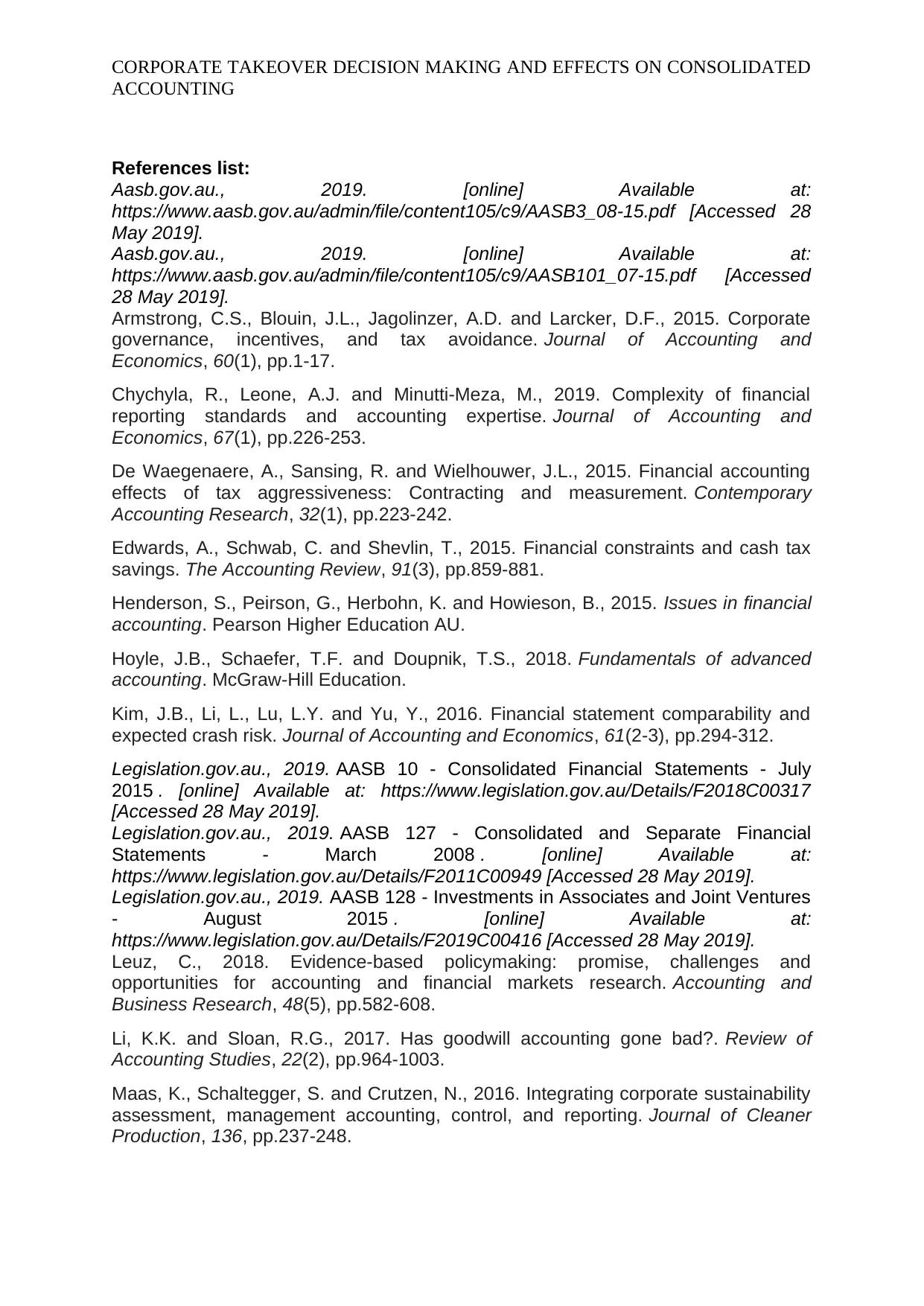
CORPORATE TAKEOVER DECISION MAKING AND EFFECTS ON CONSOLIDATED
ACCOUNTING
References list:
Aasb.gov.au., 2019. [online] Available at:
https://www.aasb.gov.au/admin/file/content105/c9/AASB3_08-15.pdf [Accessed 28
May 2019].
Aasb.gov.au., 2019. [online] Available at:
https://www.aasb.gov.au/admin/file/content105/c9/AASB101_07-15.pdf [Accessed
28 May 2019].
Armstrong, C.S., Blouin, J.L., Jagolinzer, A.D. and Larcker, D.F., 2015. Corporate
governance, incentives, and tax avoidance. Journal of Accounting and
Economics, 60(1), pp.1-17.
Chychyla, R., Leone, A.J. and Minutti-Meza, M., 2019. Complexity of financial
reporting standards and accounting expertise. Journal of Accounting and
Economics, 67(1), pp.226-253.
De Waegenaere, A., Sansing, R. and Wielhouwer, J.L., 2015. Financial accounting
effects of tax aggressiveness: Contracting and measurement. Contemporary
Accounting Research, 32(1), pp.223-242.
Edwards, A., Schwab, C. and Shevlin, T., 2015. Financial constraints and cash tax
savings. The Accounting Review, 91(3), pp.859-881.
Henderson, S., Peirson, G., Herbohn, K. and Howieson, B., 2015. Issues in financial
accounting. Pearson Higher Education AU.
Hoyle, J.B., Schaefer, T.F. and Doupnik, T.S., 2018. Fundamentals of advanced
accounting. McGraw-Hill Education.
Kim, J.B., Li, L., Lu, L.Y. and Yu, Y., 2016. Financial statement comparability and
expected crash risk. Journal of Accounting and Economics, 61(2-3), pp.294-312.
Legislation.gov.au., 2019. AASB 10 - Consolidated Financial Statements - July
2015 . [online] Available at: https://www.legislation.gov.au/Details/F2018C00317
[Accessed 28 May 2019].
Legislation.gov.au., 2019. AASB 127 - Consolidated and Separate Financial
Statements - March 2008 . [online] Available at:
https://www.legislation.gov.au/Details/F2011C00949 [Accessed 28 May 2019].
Legislation.gov.au., 2019. AASB 128 - Investments in Associates and Joint Ventures
- August 2015 . [online] Available at:
https://www.legislation.gov.au/Details/F2019C00416 [Accessed 28 May 2019].
Leuz, C., 2018. Evidence-based policymaking: promise, challenges and
opportunities for accounting and financial markets research. Accounting and
Business Research, 48(5), pp.582-608.
Li, K.K. and Sloan, R.G., 2017. Has goodwill accounting gone bad?. Review of
Accounting Studies, 22(2), pp.964-1003.
Maas, K., Schaltegger, S. and Crutzen, N., 2016. Integrating corporate sustainability
assessment, management accounting, control, and reporting. Journal of Cleaner
Production, 136, pp.237-248.
ACCOUNTING
References list:
Aasb.gov.au., 2019. [online] Available at:
https://www.aasb.gov.au/admin/file/content105/c9/AASB3_08-15.pdf [Accessed 28
May 2019].
Aasb.gov.au., 2019. [online] Available at:
https://www.aasb.gov.au/admin/file/content105/c9/AASB101_07-15.pdf [Accessed
28 May 2019].
Armstrong, C.S., Blouin, J.L., Jagolinzer, A.D. and Larcker, D.F., 2015. Corporate
governance, incentives, and tax avoidance. Journal of Accounting and
Economics, 60(1), pp.1-17.
Chychyla, R., Leone, A.J. and Minutti-Meza, M., 2019. Complexity of financial
reporting standards and accounting expertise. Journal of Accounting and
Economics, 67(1), pp.226-253.
De Waegenaere, A., Sansing, R. and Wielhouwer, J.L., 2015. Financial accounting
effects of tax aggressiveness: Contracting and measurement. Contemporary
Accounting Research, 32(1), pp.223-242.
Edwards, A., Schwab, C. and Shevlin, T., 2015. Financial constraints and cash tax
savings. The Accounting Review, 91(3), pp.859-881.
Henderson, S., Peirson, G., Herbohn, K. and Howieson, B., 2015. Issues in financial
accounting. Pearson Higher Education AU.
Hoyle, J.B., Schaefer, T.F. and Doupnik, T.S., 2018. Fundamentals of advanced
accounting. McGraw-Hill Education.
Kim, J.B., Li, L., Lu, L.Y. and Yu, Y., 2016. Financial statement comparability and
expected crash risk. Journal of Accounting and Economics, 61(2-3), pp.294-312.
Legislation.gov.au., 2019. AASB 10 - Consolidated Financial Statements - July
2015 . [online] Available at: https://www.legislation.gov.au/Details/F2018C00317
[Accessed 28 May 2019].
Legislation.gov.au., 2019. AASB 127 - Consolidated and Separate Financial
Statements - March 2008 . [online] Available at:
https://www.legislation.gov.au/Details/F2011C00949 [Accessed 28 May 2019].
Legislation.gov.au., 2019. AASB 128 - Investments in Associates and Joint Ventures
- August 2015 . [online] Available at:
https://www.legislation.gov.au/Details/F2019C00416 [Accessed 28 May 2019].
Leuz, C., 2018. Evidence-based policymaking: promise, challenges and
opportunities for accounting and financial markets research. Accounting and
Business Research, 48(5), pp.582-608.
Li, K.K. and Sloan, R.G., 2017. Has goodwill accounting gone bad?. Review of
Accounting Studies, 22(2), pp.964-1003.
Maas, K., Schaltegger, S. and Crutzen, N., 2016. Integrating corporate sustainability
assessment, management accounting, control, and reporting. Journal of Cleaner
Production, 136, pp.237-248.

CORPORATE TAKEOVER DECISION MAKING AND EFFECTS ON CONSOLIDATED
ACCOUNTING
Nilsson, F. and Stockenstrand, A.K., 2015. Financial accounting and management
control. The tensions and conflicts between uniformity and uniqueness. Springer,
Cham.
Roychowdhury, S., Shroff, N. and Verdi, R.S., 2019. The effects of financial reporting
and disclosure on corporate investment: A review. Available at SSRN 3364582.’
Wagenhofer, A., 2015. Usefulness and implications for financial accounting. The
Routledge companion to financial accounting theory, p.341.
Warren, C. and Jones, J., 2018. Corporate financial accounting. Cengage Learning.
Zhang, J. and Niu, L., 2019, May. Research on the Transition from Financial
Accounting to Management Accounting Under the Background of Big Data. In 1st
International Conference on Business, Economics, Management Science (BEMS
2019). Atlantis Press.
ACCOUNTING
Nilsson, F. and Stockenstrand, A.K., 2015. Financial accounting and management
control. The tensions and conflicts between uniformity and uniqueness. Springer,
Cham.
Roychowdhury, S., Shroff, N. and Verdi, R.S., 2019. The effects of financial reporting
and disclosure on corporate investment: A review. Available at SSRN 3364582.’
Wagenhofer, A., 2015. Usefulness and implications for financial accounting. The
Routledge companion to financial accounting theory, p.341.
Warren, C. and Jones, J., 2018. Corporate financial accounting. Cengage Learning.
Zhang, J. and Niu, L., 2019, May. Research on the Transition from Financial
Accounting to Management Accounting Under the Background of Big Data. In 1st
International Conference on Business, Economics, Management Science (BEMS
2019). Atlantis Press.
1 out of 10
![[object Object]](/_next/static/media/star-bottom.7253800d.svg)





